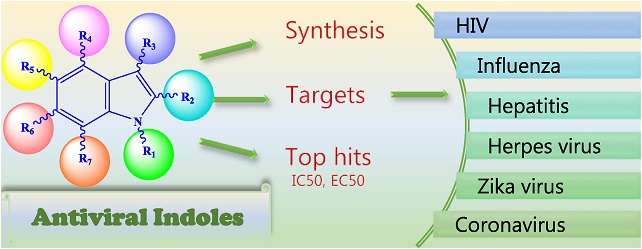Nikhil Prasad Fact checked by:Thailand Medical News Team Nov 02, 2024 11 months, 2 weeks, 1 day, 2 hours ago
Medical News: Recent years have highlighted the global need for antiviral drugs due to the impact of diseases like COVID-19, Ebola, Influenza, Zika, and Dengue. With this increased urgency, researchers are turning to compounds known as indoles for answers. This
Medical News report delves into the potential of indole-based compounds in treating viral infections, a topic explored by research groups from Guru Gobind Singh Indraprastha University, University of Delhi, and O.P. Jindal Global University.
 Indoles Offer New Antiviral Potential
Indoles Offer New Antiviral Potential
Indoles, a family of compounds found in both nature and synthetic chemistry, have demonstrated promising activity against various pathogens. Researchers aim to unlock more of their potential by modifying their structures and targeting specific viral proteins.
Understanding Indoles in Antiviral Research
For decades, indoles have captivated the interest of the pharmaceutical world due to their structural versatility and extensive biological activity. In fact, some indole-based drugs, like enfuvirtide and arbidol, have already shown effectiveness in treating viral diseases. Researchers are focusing on creating new indole derivatives and understanding their potential against a range of viral infections, from COVID-19 to Zika and Influenza.
One reason indoles are so promising is their ability to interact with biological molecules in ways that could disrupt viral replication. Through lab synthesis and computational modeling, scientists are investigating the interaction of indoles with viral target proteins. They hope that with more focused studies, they can pinpoint specific changes in indole compounds that enhance their antiviral effects.
Key Findings from the Indole Research
The review found several noteworthy results on synthesized indole compounds, and researchers used computer simulations to predict how these compounds could bind to viral proteins, increasing their therapeutic potential. Some compounds showed very low inhibitory concentrations (EC50/IC50 values), indicating high potency even at low doses. Here are a few highlights:
-HIV Research: A promising area for indoles is in combatting HIV. Researchers developed indolylarylsulfones (IASs), which have shown excellent potency against wild-type HIV-1, with certain compounds showing EC50 values as low as 4.3 nM.
Influenza Research: In the case of Influenza A, indole compounds are being tested against the virus’s neuraminidase protein. Compounds like 2,3-dihydroisoindole derivatives are showing inhibitory effects on viral proteins, paving the way for alternatives to current flu drugs.
-Zika Virus Research: Since Zika poses a significant health threat, indole derivatives have been evaluated for their effectiveness in targeting Zika’s NS2B-NS3 protease. Some disubstituted indoles showed inhibitory effects against Zika with IC50 values as low as 320 nM.
-COVID-19 Research: As COVID-19 remains a prominent global health issue, r
esearch on indoles has focused on compounds targeting SARS-CoV-2’s main protease (Mpro). Studies show that certain indole-based compounds can inhibit this protease, reducing the virus’s ability to replicate.
Broad Applications for Indole Compounds
The study findings reveal that indole compounds could serve as a base for various antiviral drugs due to their versatility. These compounds can be tailored to target viral enzymes and proteins unique to specific diseases. For example, researchers are using indole compounds to mimic peptide structures that interact with enzymes, effectively blocking the virus’s ability to multiply. The results indicate that, in the future, these compounds could play a vital role in treating infections that currently lack effective drugs.
Inhibiting Viral Growth
The indole-based compounds tested have shown potential in directly inhibiting viral replication by binding to proteins essential for the virus to multiply. This includes proteins like the HIV-1 reverse transcriptase and protease enzymes, which are crucial for the virus’s lifecycle. When compounds bind to these viral proteins, they prevent the virus from replicating, stopping the spread within the host.
Role in Drug Resistance
One of the challenges in antiviral treatments is drug resistance. The structure of indoles allows them to be modified in ways that can overcome resistance. For instance, by adding or substituting groups on the indole scaffold, researchers have achieved better binding affinity to mutated viral enzymes, a common problem in HIV treatment.
Future of Indoles in Antiviral Therapy
The study emphasizes the potential of indoles in offering new approaches to antiviral therapy, particularly for diseases where current treatments are limited or ineffective. Computational studies, a major part of this research, predict that further modifications in the indole structure could lead to even more effective drugs.
Indoles stand out for their ability to act on multiple viral targets, a trait that makes them attractive candidates for broad-spectrum antivirals. With continued research, these compounds could pave the way for drugs that not only target specific viruses but also adapt to viral mutations. This adaptability could make indole-based drugs a valuable tool in global health.
Conclusion
Indole compounds show significant promise as antiviral agents, with research suggesting they could help in treating viruses like HIV, Influenza, COVID-19, and Zika. The study results emphasize the need for further research, particularly in optimizing these compounds for enhanced potency and reduced resistance.
The versatility of indoles, combined with their natural bioactivity, positions them as a crucial scaffold for future antiviral therapies. Continued investigation into indoles’ pharmacological properties and structural adaptability could transform them into a cornerstone of antiviral drug development, potentially leading to breakthroughs in combatting viral infections.
The study findings were published in the peer-reviewed journal: European Journal of Medicinal Chemistry.
https://www.sciencedirect.com/science/article/abs/pii/S0223523424008997
For the latest about Indoles, keep on logging to Thailand
Medical News.
Read Also:
https://www.thailandmedical.news/news/breaking-gut-molecule-indole-3-propionic-acid-ipa-shows-promise-in-fighting-all-types-of-influenzas
https://www.thailandmedical.news/news/indole-from-cruciferous-vegetables-helps-fight-fatty-liver-disease
